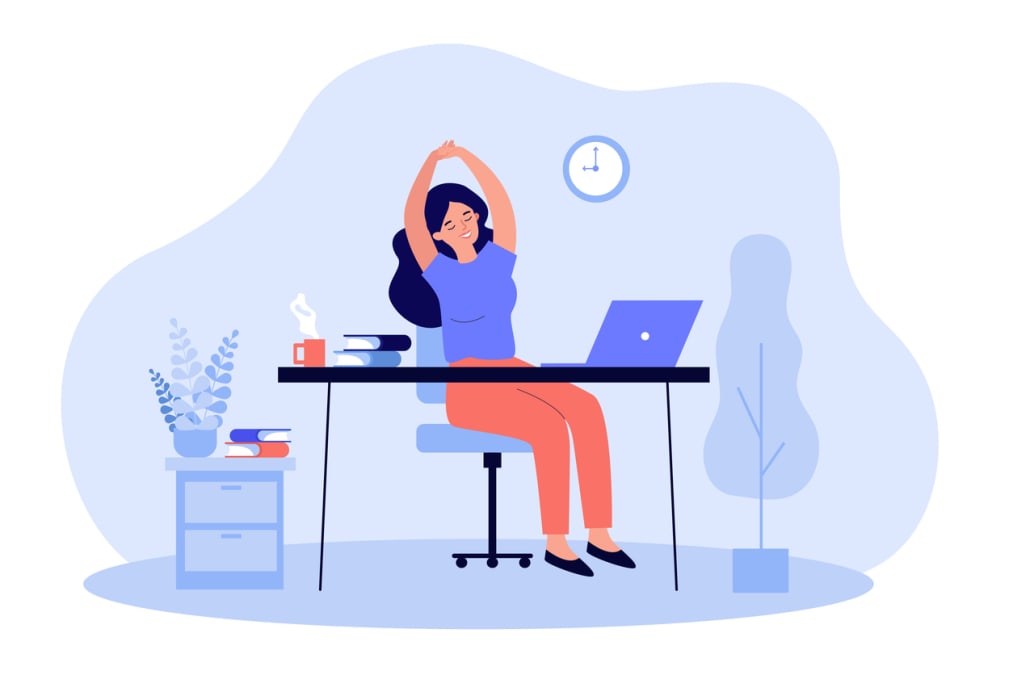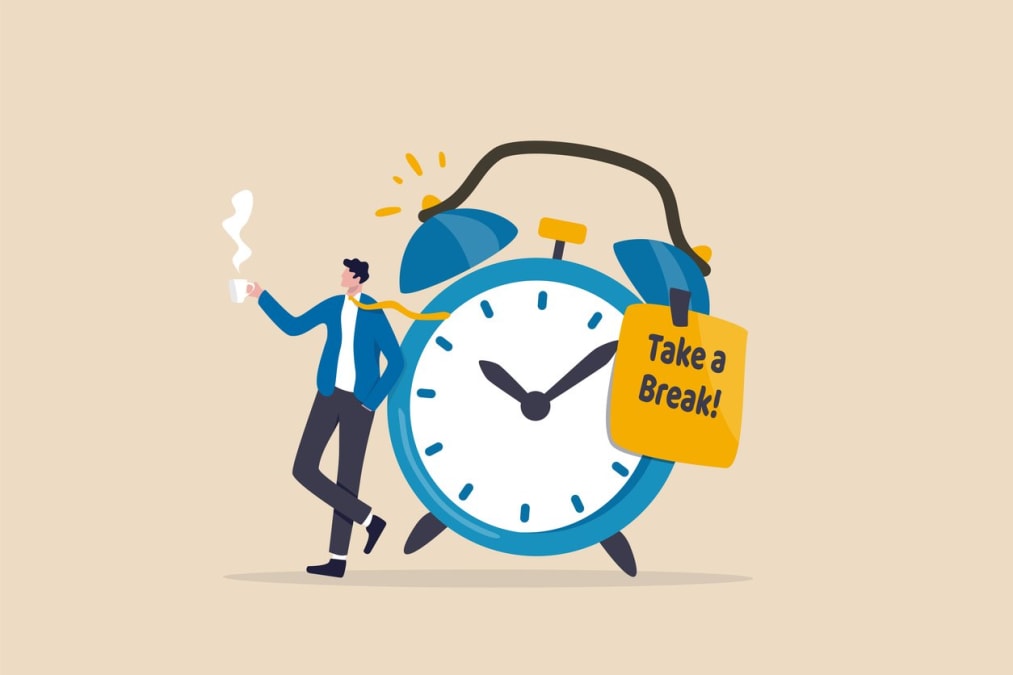If you’re questioning whether taking breaks at work can truly ramp up your productivity, this guide has your answer. Ditching the non-stop grind for smart, timely breaks could be your key to sustained focus and energy. Here, we’ll dissect why breaks are crucial and how you can implement them in your daily routine to recharge and prevent burnout, ensuring you stay at the top of your game.
Key takeaways
- Regular breaks, including micro-breaks, enhance productivity by preventing decision fatigue, reducing stress, and encouraging consistent performance levels.
- Different types of breaks offer specific benefits, with activities such as physical exercises, relaxation, and socializing having distinct positive impacts on employee wellbeing and job performance.
- Creating balanced company break policies requires compliance with labor laws, flexibility to accommodate employee needs, and tools to monitor adherence, all while avoiding the drawbacks of excessive breaks and promoting a positive break culture.
Understanding the power of breaks

You might be surprised to learn that the average employee is productively engaged for less than three hours in an eight-hour workday, especially during the afternoon. That’s where the power of breaks comes into play. Contrary to being distractions, regular breaks during the workday allow employees to decompress, which aids in preventing decision fatigue and maintaining consistent performance. In fact, breaks can be the answer to boosting overall productivity once employees have decided on an effective break schedule throughout the week.
Even short pauses can make a difference. Micro-breaks, which are breaks of up to 10 minutes, are scientifically proven to boost individuals’ vigor and reduce fatigue. If you’ve ever felt more energized after a quick coffee break, you’ve experienced this firsthand. Companies like Kumospace recognize this, promoting the principle that break times are intrinsically linked to an employee’s productivity and well-being.
The science behind breaks
Exploring the science behind breaks, theories like the Conservation of Resources (COR) and the Effort Recovery Model (ERM) suggest that recuperating from work demands via breaks helps prevent stress by ensuring demands don’t deplete personal resources. Simply put, taking regular breaks can keep stress levels manageable and boost your productivity.
The benefits of breaks extend to more than just stress reduction. Research shows that breaks can enhance learning and problem-solving by allowing the brain to transition from focused to diffuse mode of thinking, facilitating information retention and connection making. So the next time you’re stuck on a tough problem, consider taking a break. You might return with a fresh perspective and a creative solution.
Types of breaks and their benefits
Not all breaks are created equal. Different types of breaks offer distinct benefits. For instance, longer breaks result in greater performance improvements and are critical for recovery. Various break activities such as:
- physical exercises
- relaxation
- socializing
- cognitive tasks
offer distinct positive impacts on an employee’s well-being and job outcomes.
Physical activities such as stretching can directly reduce fatigue and psychological tension, leading to better physical and mental health as well as enhanced job performance. Social and nutritional breaks, while not directly linked to positive mood or job performance, play a key role through the aspect of social interaction, with casual co-worker conversations and coffee or snack breaks fostering a positive workplace atmosphere. For those interested in exploring this topic further, related questions may arise about the specific benefits of different types of breaks and their impact on overall well-being.
Maximizing break efficiency

Taking breaks is crucial, but it’s equally important to maximize their efficiency. This involves strategically incorporating breaks into your daily work schedule. Think of it as interval training for your brain. You wouldn’t run a marathon without taking water breaks, so why would you work an entire day without giving your brain a chance to rest and recharge?
For optimal effectiveness, breaks are recommended every 2 hours, ideally lasting 15 to 30 minutes. These planned pauses can enhance productivity without disrupting workflow. If you’re worried about losing momentum, remember that a well-timed break can actually boost your energy and focus for the next work sprint.
Timing your breaks right
Determining the best pattern for your breaks may require some trial and error. The productivity app DeskTime suggests a 17-minute break after every 52 minutes of work for optimal productivity. On the other hand, the Pomodoro Technique advocates for a 5-minute break after every 25 minutes of work, plus a 30-minute break after four cycles.
There’s no one-size-fits-all approach here. Optimal break schedules can vary, and experimenting with breaks ranging from every 30 to 90 minutes can help determine the most effective rhythm for individual productivity. So feel free to try different break schedules and find what works best for you.
Activities to boost break value
The activities you engage in during your breaks are as significant as the timing of these breaks. Activities like practicing meditation or spending time in nature during breaks can significantly decrease stress levels. So instead of scrolling through social media on your phone, consider doing a quick meditation or stepping outside for a breath of fresh air.
Similarly, engaging in moderate physical activities such as walking, climbing stairs, or stretching during breaks can invigorate both body and mind, leading to better cognitive performance and a boost in creativity. And don’t underestimate the power of a good snack. Consuming a nutritious snack during morning breaks can help combat energy slumps, replenishing energy which is essential for maintaining concentration and productivity through the workday.
Navigating company break policies

In terms of implementing break times in a work setting, it’s crucial for companies to find a balanced approach. They need to comply with the legal requirements for breaks in their specific jurisdiction, considering local, state, and federal laws. At the same time, they need to consider the wellness of employees and the company’s operational necessities. Kumospace, an innovative video conferencing platform company, is renowned for its purely virtual company culture.
Creating an effective lunch break policy, for example, requires clear guidelines on the amount of break time allotted per number of hours worked. It’s also important to use break management tools to efficiently share updated break policies with employees and ensure adherence to evolving labor laws. In this way, companies can create a work environment that respects employees’ need for breaks while also maintaining a productive workflow.
Balancing flexibility and structure
Like many aspects of life, maintaining balance is crucial in formulating break policies during working hours. A typical approach offers rest breaks of up to 15 minutes; employees working over 6 hours receive two, while those with 5 hours or less get one. Lunch breaks, which generally span 30-60 minutes, are coordinated with supervisors for seamless work coverage.
But while structure is important, so is flexibility. For unexpected needs like illness or urgent calls, employers should accommodate emergency breaks, contingent on supervisor notification. Flextime lets employees determine early start and end times while upholding daily work hours, supporting a balance of flexibility and schedule predictability.
Through a combination of structure and flexibility, companies can create break policies that meet both employer and employee needs.
Tools for monitoring and managing breaks
While keeping track of breaks might appear overwhelming, there are thankfully tools at your disposal that can simplify the process. Break monitoring tools such as:
Our system provides real-time tracking of work hours and break usage, with features like multiple punch-ins and punch-outs, detailed break tracking, and GPS geofencing for accurate timesheet and payroll calculations at any point.
These tools also offer customization for break periods based on employee tasks, location, and department. Managers can receive and approve break requests through the software, ensuring oversight of break compliance, while online systems allow employees to track their own work hours and breaks. This means that companies can ensure adherence to company break policies and maintain an efficient workflow.
When breaks become excessive

Though regular breaks are advantageous, an overabundance can cause issues. They can result in a disengaged workforce due to employees emulating colleagues who take too many breaks. Addressing the issue of excessive breaks can be tricky, but it’s crucial for maintaining a productive and engaged team.
To address this issue, an employee attendance write-up can be utilized as a formal measure. However, it’s important to approach the situation with understanding and empathy, focusing on the well-being of the team and setting clear expectations for break times.
Identifying the signs
Recognizing excessive breaks can be a demanding task, but there are specific indicators that can assist in this process. For instance, employees regularly leaving the office for extended periods without explanation, especially when it deviates from the team’s norm, may signify excessive break-taking. Similarly, taking longer breaks than allowed on a frequent or predictable basis can indicate an employee is abusing their allocated break time.
Remember, it’s not just about the quantity of breaks, but also the quality of engagement. Highly engaged employees may require fewer mood-boosting breaks, potentially reducing the instances of excessive break-taking. It’s important to look at the overall picture, taking into account both the pattern of absences and the quality of work.
Constructive conversations
After detecting the signs of excessive breaks, it becomes necessary to initiate a discussion. Managers should start these discussions by showing concern for the team’s well-being rather than directly critiquing the employee’s actions. Clear expectations must be communicated about required availability during work hours and the effects of unexpected or lengthy breaks on the team.
It’s also crucial to document these discussions, providing employees with follow-up resources, like benefits information or leave policies. This not only helps maintain a record of the conversation but also provides the employee with additional resources to manage their time effectively. Remember, the goal is not to penalize, but to promote a healthy balance between work and rest.
Implementing a healthy break culture

Establishing a healthy break culture goes beyond just formulating policies; it involves fostering a supportive environment. This includes physical aspects, such as redecorating with ergonomic furniture, soothing colors, and plants, to create a workspace conducive to taking productive breaks. Companies like Kumospace exemplify this by encouraging and supporting the habit of taking breaks.
More importantly, a healthy break culture involves a shift in mindset. It requires recognizing rest not as a luxury, but as a necessity for maintaining productivity and well-being. It’s about moving away from the ‘always-on’ culture and celebrating rest as a path to success.
Leading by example
Setting an example is one of the most potent ways to cultivate a healthy break culture. Managers can do this by:
- Personally adhering to scheduled breaks
- Encouraging their team to take regular breaks every 90 to 120 minutes
- Showing respect for their team’s right to uninterrupted breaks by ensuring they do not send messages or emails during typical break times.
In addition to these practices, managers can:
- Use platforms like Kumospace to showcase their commitment to breaks in a virtual office environment
- Share how breaks have personally enhanced their productivity and creativity
- Endorse the effectiveness of taking breaks and foster a supportive break culture amongst employees.
Celebrating rest as a path to success
Senior leaders hold a crucial position in the development of a break culture. They can:
- Discuss the importance of breaks in team meetings and one-on-one sessions, emphasizing the organization’s dedication to employee well-being.
- Acknowledge that breaks contribute to increased productivity, a stronger work-life balance, and the creation of superior ideas.
- Establish rest as an essential component of professional success.
Recognition programs that commend employees for exemplifying a balanced approach to work and life, encapsulating the importance of regular breaks, serve to highlight the organizational value placed on rest. In this way, companies can create a culture that not only allows for breaks but celebrates them as a vital part of success, even incorporating the company logo into these programs as a symbol of this commitment.
Summary
In conclusion, taking regular breaks isn’t just beneficial, it’s essential. Whether you’re an employee looking to boost your productivity or a manager striving to create a positive work environment, understanding the power of breaks is key. From the science behind breaks to strategies for maximizing their efficiency, and from navigating company break policies to fostering a healthy break culture, this guide has covered it all. Remember, the key to a productive workday might just be knowing when to step away.
Frequently asked questions
Taking breaks means stopping an activity for a short period to rest, pause or refresh. It allows you to regain energy and focus for better productivity.
Yes, it is okay to take breaks at work. Taking short breaks every hour can help you stay productive throughout the workday.
It is recommended to take a break at least every 45-60 minutes, ideally more often, to maintain efficient work. Our ability to focus fluctuates and taking regular breaks can help boost productivity.
To ensure adherence to company break policies, consider using break management tools to share updated policies with employees and comply with labor laws effectively.
Some signs of excessive breaks may include employees leaving the office for extended periods without explanation or taking longer breaks than allowed on a frequent basis. Watch out for these behaviors to ensure productivity.





